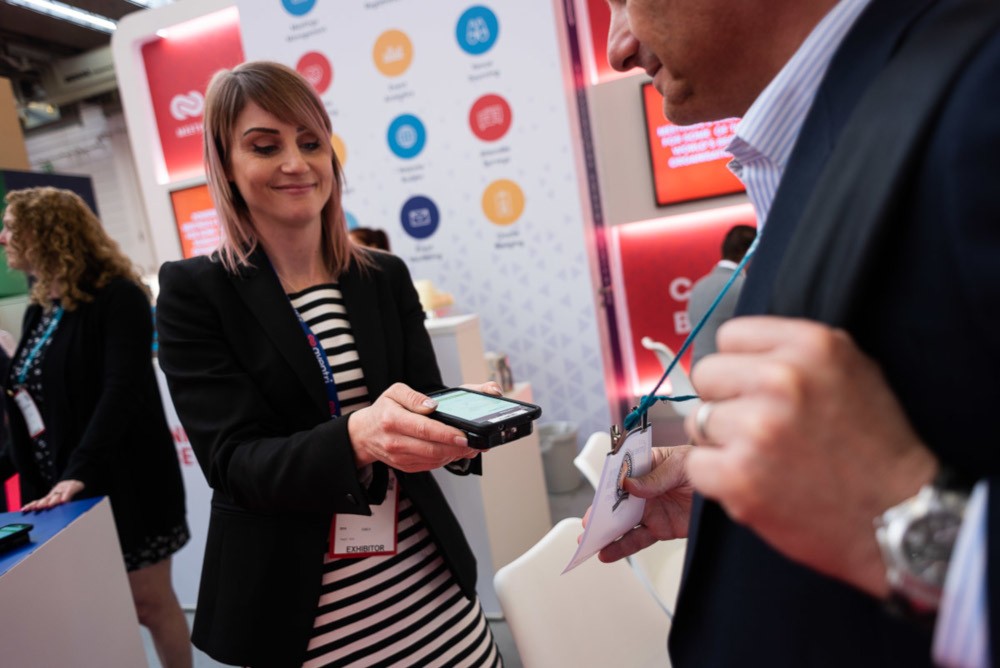For maintaining continuity with customers and getting business done, nothing beats face-to-face meetings and events.
We’re confident the industry will see a strong rebound, driven by pent-up demand.
That said, COVID-19 has upended operations and created a “new normal.” Organizers today want technologies to help maintain social-distancing guidelines and make their events as touchless as possible.
To this end, these nine tech tools below can help you get back to business, while keeping attendees and stakeholders safe. Use these flexible solutions separately or together. They’re good for small meetings in the near term and later, when large-scale events come back.
Hybrid Events Reduce Risk, Extend Reach
1. All-in-One Platforms
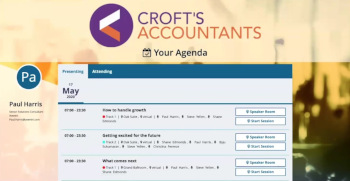 Hybrid is the future of meetings and events. In fact, 91% of global event organizers say virtual components will remain critical post-pandemic, according to a survey conducted in April by Aventri. (photo: Hybrid event agenda; Credit: Aventri)
Hybrid is the future of meetings and events. In fact, 91% of global event organizers say virtual components will remain critical post-pandemic, according to a survey conducted in April by Aventri. (photo: Hybrid event agenda; Credit: Aventri)
Organizers see hybrid events as a way to expand audience reach and reduce risk. If an emergency arises, they want a back-up plan. New integrated virtual/hybrid/in-person meeting platforms make it easy to switch. Organizers can change formats simply by clicking a box to enable a virtual event.
Modern platforms create immersive experiences. Remote attendees can engage using features like real-time Q&As, instant polling, virtual exhibit halls, video chats, gamification, sponsored giveaways, curated breakout groups and more.
How Hybrid Events Help
- Even after large face-to-face events resume, some constituents will remain skittish and want the option to attend remotely. A hybrid approach enables participation by people not willing or able to travel.
- Hybrid events help offset reduced occupancy during social-distancing restrictions.
- They create new revenue streams through sponsorship opportunities.
- Organizers can store content in digital libraries and continuing education stores and sell access long after the live event concludes.
[Explore the ‘New Normal’ With Our Free Navigating the New Meetings Landscape eHandbook]
Contactless Technologies Improve Health, Safety
2. NFC Badges and Wristbands
 Exchanging business cards involves lots of shared surfaces. By contrast, the latest badges and wristbands use near-field communication (NFC) technologies for secure information exchange without swapping, swiping or scanning. (photo: NFC badge; Credit: Aventri)
Exchanging business cards involves lots of shared surfaces. By contrast, the latest badges and wristbands use near-field communication (NFC) technologies for secure information exchange without swapping, swiping or scanning. (photo: NFC badge; Credit: Aventri)
If you use Apple Pay, you’re already familiar with this technology. At events, NFC-wearable devices enable easy payments as well as lead retrieval, session tracking, materials distribution and more. The technology works within a range of just a few inches…meaning there’s less chance of personal information theft.
How They Help
- As a contactless way to exchange information, NFC wearables replace business cards and help reduce the spread of germs.
- There’s no need to touch bills, coins or credit card readers, either. Using a digital wallet feature, attendees load money or tokens onto their badges and make purchases by simply touching their badge to an NFC-enabled device.
3. Integrated Check-In and Badging
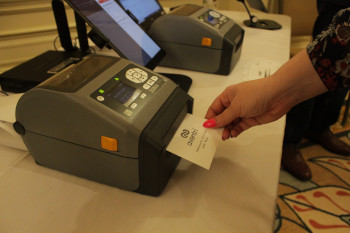 Long queues at registration don’t work for social distancing. Fortunately, the latest check-in applications remove bottlenecks.(photo: Contactless check-in; Credit: Aventri)
Long queues at registration don’t work for social distancing. Fortunately, the latest check-in applications remove bottlenecks.(photo: Contactless check-in; Credit: Aventri)
They connect directly with badge printers and attendee registration platforms. Organizers can check people in with one tap and print out a badge in seconds. Or, attendees can print their badges at home and stop at a self-scan registration point at the event entrance.
How They Help
- Apps work with smart badges and wristbands to provide contactless check-in.
- By combining check-in and badging, they eliminate long lines and wait times. Attendees can breeze through the process while keeping safe distances.
- These solutions work online and offline. Check-in and badging continue even during Wi-Fi interruptions.
[Related: Here’s What Hotels and Resorts Are Doing to Enhance Health and Sanitation Standards]
4. NFC Readers
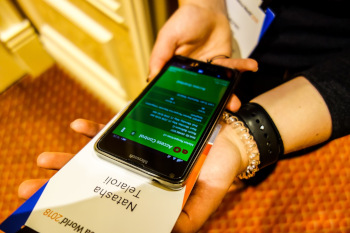 The registration desk isn’t the only place where gridlock occurs. NFC streamlines session check-in and tracking as well. Place customizable pods equipped with NFC readers outside session rooms. Attendees simply tap their badges to the reader and get their attendance counted. (photo: Pod with NFC hot spot and reader; Credit: Aventri)
The registration desk isn’t the only place where gridlock occurs. NFC streamlines session check-in and tracking as well. Place customizable pods equipped with NFC readers outside session rooms. Attendees simply tap their badges to the reader and get their attendance counted. (photo: Pod with NFC hot spot and reader; Credit: Aventri)
Don’t limit NFC readers to session tracking; they help control access as well. When attendees move in and out of spaces, these tools read credentials and display space capacity status in real time.
How They Help
- With up-to-the-second capacity updates, organizers can control access as needed to help ensure social distancing.
- They can spot a potential issue before it arises and adjust access to improve traffic flow around sessions and across the show floor.
- Think of all the hands that touch paper session sign-in sheets at small meetings. NFC tracking makes this practice obsolete.
- NFC readers cut down on staffing needs. This is an important consideration in a post-COVID-19 world, when meeting planning teams will be working with reduced resources.
Artificial Intelligence Personalizes the Experience
5. AI-Driven Check-In Platforms
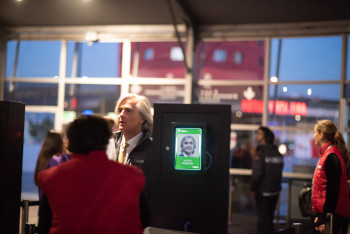 Post-pandemic events will see a spike in personalization solutions. For example, the latest onsite technologies scan smart badges. Then, they leverage artificial intelligence to recommend sessions, exhibitors and other event-goers to connect with based on the attendee’s registration data and preferences. (photo: Facial recognition check-in; Credit: Aventri)
Post-pandemic events will see a spike in personalization solutions. For example, the latest onsite technologies scan smart badges. Then, they leverage artificial intelligence to recommend sessions, exhibitors and other event-goers to connect with based on the attendee’s registration data and preferences. (photo: Facial recognition check-in; Credit: Aventri)
For large tradeshows, facial recognition creates a personalized, efficient welcome. State-of-the-art systems greet the attendee by name, verify registration and print a custom badge in seconds. Must-haves for success with facial recognition include great cameras and lighting, processing power and facial recognition engine. Also, make sure your platform doesn’t store images but uses them to create digital signatures just for the event.
How They Help
- New technologies enhance check-in, while cutting down on the number of surfaces attendees must touch.
- Speedy check-in reduces lines to satisfy social-distancing requirements.
- Recommendation engines boost attendee satisfaction. No matter the event size, guests enjoy a customized, VIP experience.
6. EventBots
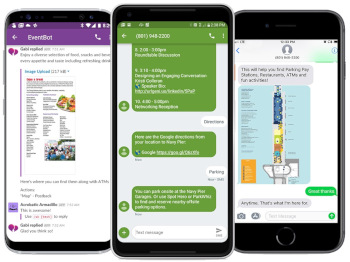 These tools provide quick answers to common event questions, such as: Where’s the awards dinner? What’s the dress code? How can I get gluten-free meals? (photo: EventBots answering common questions; Credit: Aventri)
These tools provide quick answers to common event questions, such as: Where’s the awards dinner? What’s the dress code? How can I get gluten-free meals? (photo: EventBots answering common questions; Credit: Aventri)
EventBots can provide thousands of accurate answers at once, with an average response time per inquiry of a few seconds. They work best on mobile devices and deliver content through SMS, WebChat, Facebook Messenger, Twitter and other popular channels.
How They Help
- EventBots cut crowds around event information booths.
- They reduce staff needs, which is critical for teams working with fewer resources.
- No matter the size of your in-person gathering, EventBots are a great way to reach participants in an instant if an emergency arises.
Mobile Event Apps Do More
7. Contactless Entry, Q&As
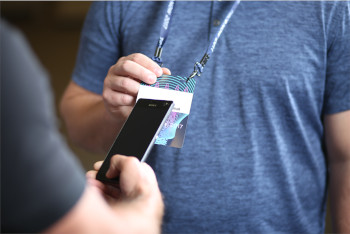 In a post-coronavirus shutdown world, organizers will turn to event apps more than ever to minimize shared touch points. Expect to see increased app usage by attendees to enter sessions, store marketing materials digitally, and more. (photo: In-app badges; Credit: Aventri)
In a post-coronavirus shutdown world, organizers will turn to event apps more than ever to minimize shared touch points. Expect to see increased app usage by attendees to enter sessions, store marketing materials digitally, and more. (photo: In-app badges; Credit: Aventri)
Another pre-COVID-19 shutdown event staple apps can replace: passing the microphone down the aisle from person to person during Q&A sessions. Many apps let attendees submit questions from their phones to large display screens at the front of the room for speakers to answer.
How They Help
- Apps for session Q&As can slow the spread of coronavirus as well as colds and flu.
- They keep a digital record of questions asked, providing valuable insights to session sponsors.
- Paper handouts will vanish. Capturing and storing marketing materials digitally is environmentally conscious. Plus, it means less contact and shared surfaces.
8. Lead Retrieval Apps
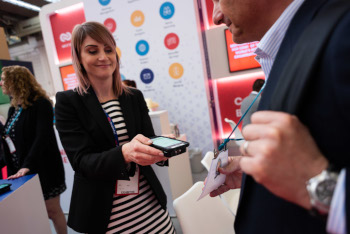 Paper business cards will also go the way of the handshake in the new normal brought on by COVID-19. So how can exhibitors capture quality leads? (photo: Lead retrieval app; Credit: Aventri)
Paper business cards will also go the way of the handshake in the new normal brought on by COVID-19. So how can exhibitors capture quality leads? (photo: Lead retrieval app; Credit: Aventri)
Lead retrieval apps are the answer. They take just a second to scan a badge and collect contact details. Exhibitors can upload contacts directly to their customer relationship management and marketing automation systems.
Thanks to the data capture capabilities of NFC, organizers optimize sponsorship value with robust reports to sponsors. They can share valuable metrics like booth traffic, dwell time, repeat visits, questions asked and more. Smart companies leverage these insights to customize sales and marketing follow-up.
How They Help
- In a challenging economy, showing a return on investment is more important than ever. These solutions answer the call with data-rich ROI reports organizers can create in minutes.
- Exhibitors install the apps on their smartphones or use scanners for touchless lead capture.
- Lead retrieval apps provide a record of onsite interactions. They can help with contact tracing if an attendee tests positive onsite or during the COVID-19 incubation period after the event.
- Here again, streamlined processes mean more leads with less crowds.
9. Swag Bag Apps
 How else can event apps help keep in-person events safe? Swag bag apps present an efficient, trackable way to distribute guest content and gifts. (photo: Swag bag app; Credit: Aventri)
How else can event apps help keep in-person events safe? Swag bag apps present an efficient, trackable way to distribute guest content and gifts. (photo: Swag bag app; Credit: Aventri)
These tools scan credentials and give away items onsite through rules and inventory control. Organizers can customize content by role, sponsorship level, industry and more. They get a record of what was picked up or left behind to improve planning for future events.
How They Help
- Swag bag apps minimize handling.
- Using these apps, organizers easily improve health and safety through access control and social distancing between pickup points.
Closing Thoughts
These are just a few of the tools you have at your disposal.
As Charles Darwin indicated, succeeding isn’t always about being the smartest or working the hardest. It’s about being flexible and adapting quickly to change.
Our industry will make a strong comeback, fueled by pent-up demand. But make no mistake, the ground has shifted.
Use this time to take stock of your processes and develop new solutions to major event challenges. These are the qualities you’ll need to thrive in the post-pandemic new normal for meetings and events.
Read Next: What Will Hotels and Conferences Look Like Post COVID-19?
About the Author
Mike Sorgani is vice president of Experiential Solutions at Aventri, a global leader in data-driven, end-to-end meeting and event management solutions.


